CKA Certification Course - Certified Kubernetes Administrator
Mock Exams
Mock Exam 3 Step by Step Solutions
This lesson presents detailed solutions for each question in Mock Exam Three. Each solution focuses on a specific Kubernetes task and provides clear instructions, configuration code blocks, and diagram references. All image links and descriptions remain exactly as provided.
Question 1 – Adjusting Network Parameters for Kubernetes
To deploy a Kubernetes cluster using kubeadm, you must enable IPv4 packet forwarding and ensure the settings persist across reboots. Refer to the kubeadm documentation for guidance when provisioning a new cluster.
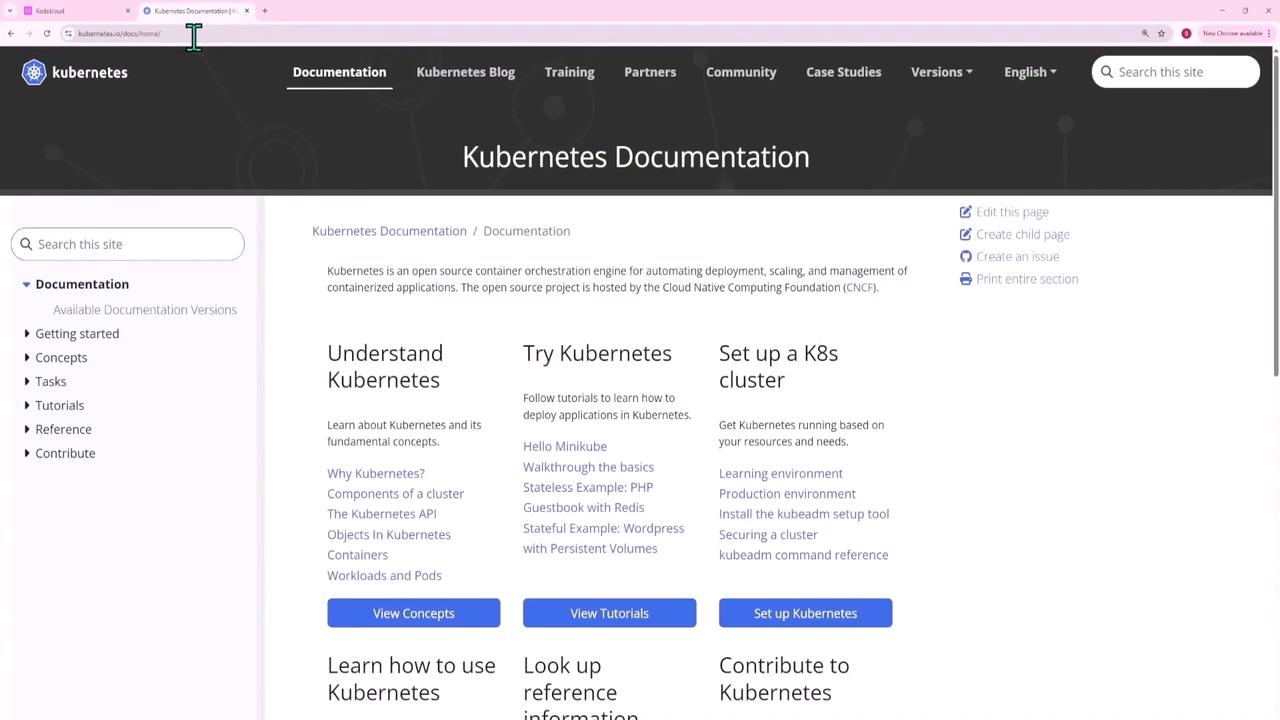
Searching for “kubeadm” in the docs will help you locate the bootstrapping guide.
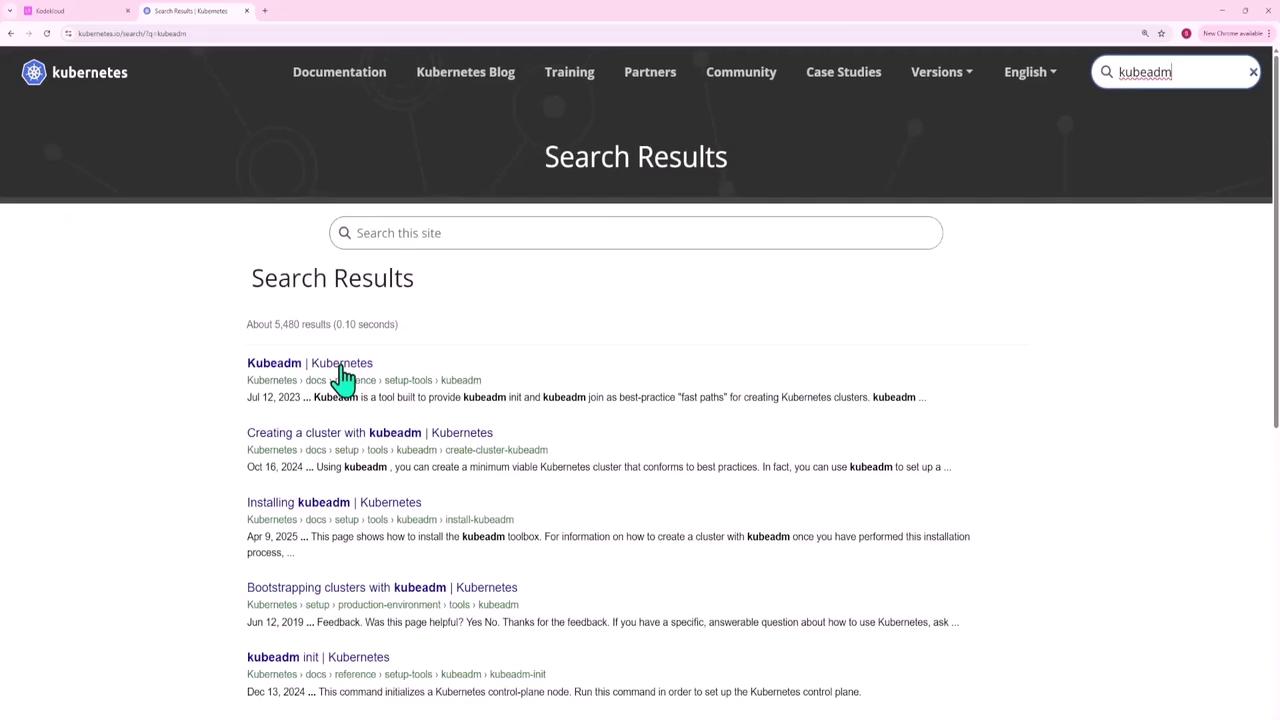
Navigate through the following path: Production Environment → Installing Kubernetes Deployment Tools → Bootstrapping a Cluster → Creating a Cluster with kubeadm.
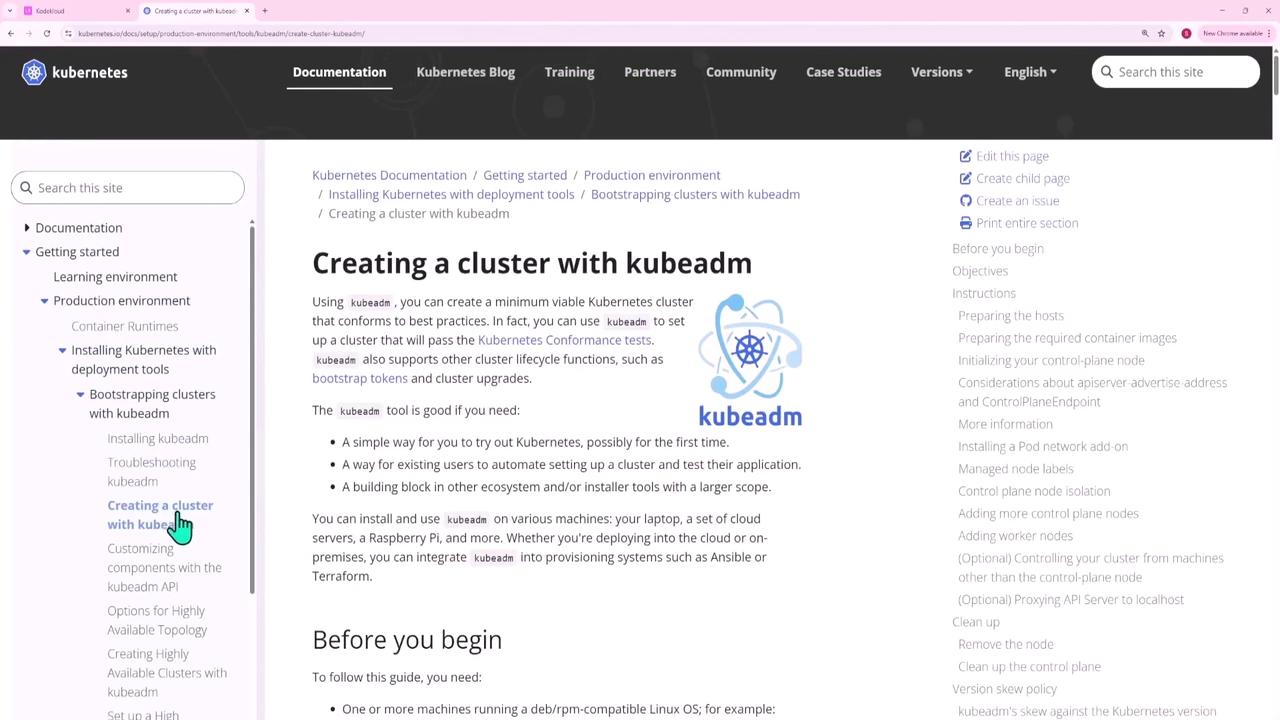
The first step is to set up a container runtime and enable IPv4 packet forwarding using these commands:
cat <<EOF | sudo tee /etc/sysctl.d/k8s.conf
net.ipv4.ip_forward = 1
EOF
sudo sysctl --system
sysctl net.ipv4.ip_forward
For additional persistence, use this command if provided:
# sysctl params required by setup, params persist across reboots
cat <<EOF | sudo tee /etc/sysctl.d/k8s.conf
net.ipv4.ip.forward = 1
EOF
# Apply sysctl params without reboot
sudo sysctl --system
Tip
Always copy the exact command names from the exam instructions to avoid errors.
This completes Question 1.
Question 2 – Creating a Service Account and Granting PVC Listing Permissions
In this question you will:
- Create a service account named pvviewer.
- Create a cluster role (pvviewer-role) that grants permission to list persistent volumes.
- Bind the role to the service account with a cluster role binding (pvviewer-role-binding).
- Launch a pod (pvviewer) using the Redis image in the default namespace.
Step 1: Create the Service Account
kubectl create serviceaccount pvviewer
kubectl get sa
Expected output:
NAME SECRETS AGE
default 0 6m55s
pvviewer 0 5s
Step 2: Create the Cluster Role
Create the role with the required permission:
kubectl create clusterrole pvviewer-role --resource=persistentvolumes --verb=list
Verify with:
kubectl describe clusterrole pvviewer-role
Expected output snippet:
Name: pvviewer-role
Labels: <none>
Annotations: <none>
PolicyRules:
Resource Non-Resource URLs Resource Names Verbs
------------------ ----------------- -------------- -----
persistentvolumes [] [] [list]
Step 3: Bind the Role to the Service Account
kubectl create clusterrolebinding pvviewer-role-binding --clusterrole=pvviewer-role --serviceaccount=default:pvviewer
Step 4: Launch the Pod
Create a pod manifest (e.g., question2.yaml):
apiVersion: v1
kind: Pod
metadata:
name: pvviewer
spec:
serviceAccountName: pvviewer
containers:
- name: pvviewer
image: redis
Apply the manifest:
kubectl apply -f question2.yaml
Verify the pod and its service account:
kubectl get pod
kubectl describe pod pvviewer
This completes Question 2.
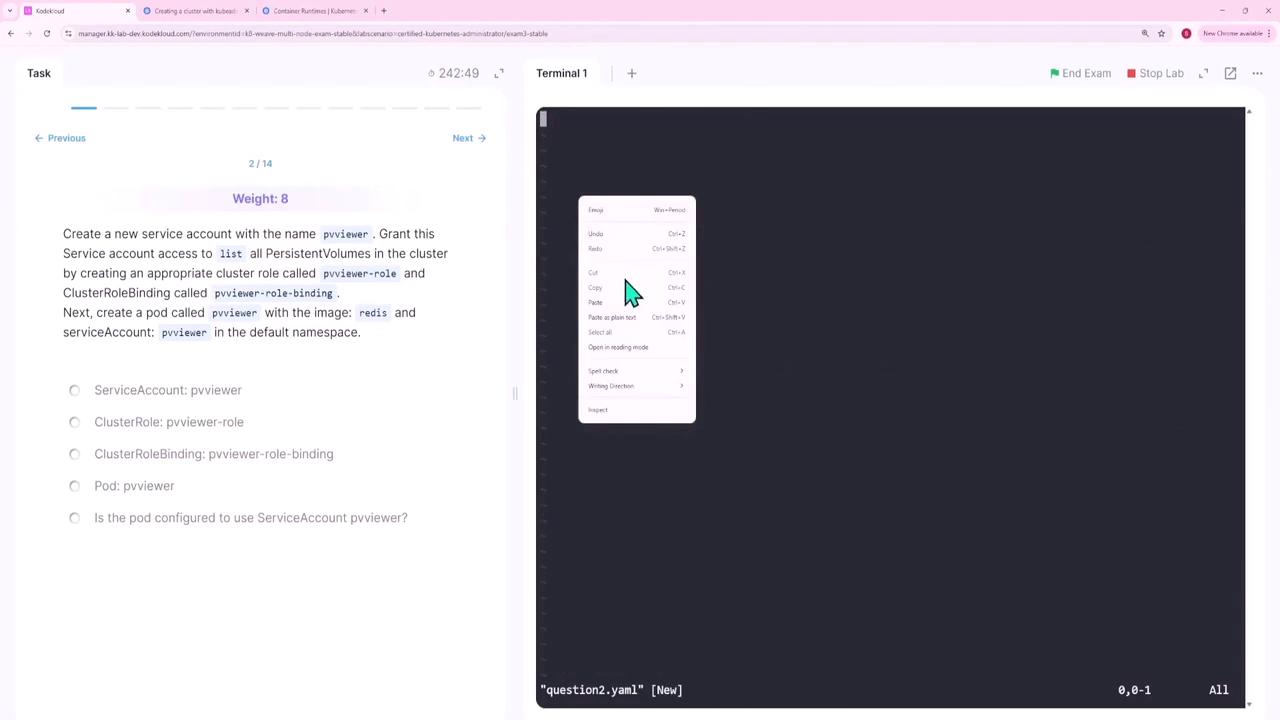
Question 3 – Creating a Storage Class
Create a storage class called rancher-sc with these settings:
- Provisioner:
rancher.io/local-path - Allow volume expansion:
true - Volume binding mode:
WaitForFirstConsumer
Example manifest (question3.yaml):
apiVersion: storage.k8s.io/v1
kind: StorageClass
metadata:
name: rancher-sc
provisioner: rancher.io/local-path
allowVolumeExpansion: true
volumeBindingMode: WaitForFirstConsumer
Apply the storage class:
kubectl apply -f question3.yaml
This completes Question 3.
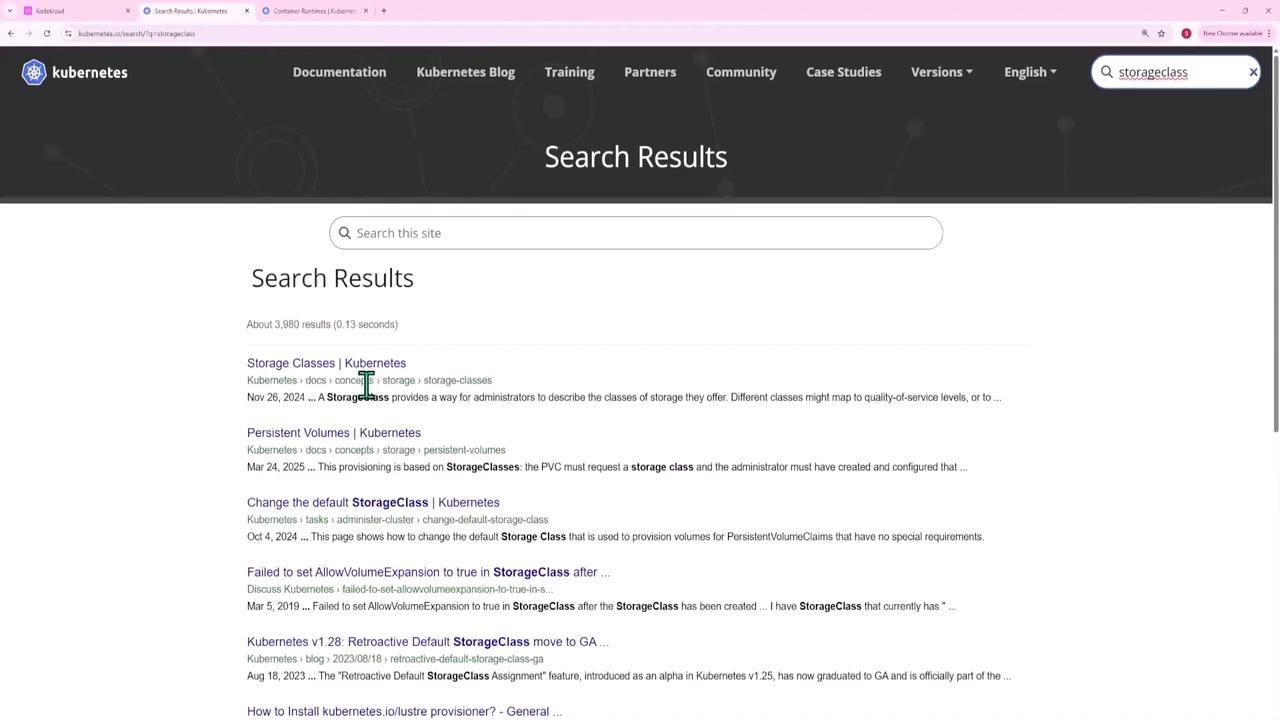
Question 4 – Configuring a ConfigMap and Updating a Deployment
In the cm-namespace, perform these tasks:
- Create a ConfigMap app-config containing key-value pairs such as
ENV=productionandLOG_LEVEL=info. - Update the existing deployment cm-web-app to source environment variables from the ConfigMap.
Step 1: Create the ConfigMap
kubectl create configmap app-config -n cm-namespace --from-literal=ENV=production --from-literal=LOG_LEVEL=info
Verify with:
kubectl describe cm app-config -n cm-namespace
Step 2: Update the Deployment
Edit the deployment to include the ConfigMap:
kubectl edit deployment cm-webapp -n cm-namespace
Add the following under the container section:
envFrom:
- configMapRef:
name: app-config
After saving, verify that new pods include the environment variables from app-config.
This completes Question 4.

Question 5 – Configuring Priority Classes and Pod Priority
For this task, you need to:
- Create a PriorityClass low-priority with a value of 50,000.
- Modify the existing pod lp-pod (in the low-priority namespace) to reference this PriorityClass.
- Recreate the pod so that it picks up the new priority without manually setting a numeric value.
Step 1: Create the PriorityClass
Create a manifest (e.g., question5.yaml):
apiVersion: scheduling.k8s.io/v1
kind: PriorityClass
metadata:
name: low-priority
value: 50000
globalDefault: false
description: "This is a low priority class"
Apply it:
kubectl apply -f question5.yaml
Step 2: Update the Pod Manifest
Create or edit the pod manifest (e.g., question5-pod.yaml) to include only the PriorityClass name:
apiVersion: v1
kind: Pod
metadata:
name: lp-pod
namespace: low-priority
labels:
run: lp-pod
spec:
priorityClassName: low-priority
containers:
- name: lp-pod
image: nginx
imagePullPolicy: Always
resources: {}
terminationMessagePath: /dev/termination-log
terminationMessagePolicy: File
dnsPolicy: ClusterFirst
restartPolicy: Always
Do not include a numeric priority field.
Replace the pod if needed:
kubectl replace -f question5-pod.yaml --force
# If an error appears about a numeric priority, remove any "priority: 0" specification and apply again:
kubectl apply -f question5-pod.yaml
Finally, verify the pod:
kubectl get pod -n low-priority
This completes Question 5.
Question 6 – Fixing Incoming Connection Issues with a Network Policy
A pod (np-test-1) and its service (np-test-service) are not receiving incoming traffic on port 80. Create a NetworkPolicy named test-network-policy to allow TCP traffic on port 80.
First, confirm the pod’s labels:
kubectl get pod --show-labels
Then, create a manifest (e.g., question6.yaml):
apiVersion: networking.k8s.io/v1
kind: NetworkPolicy
metadata:
name: test-network-policy
namespace: default
spec:
podSelector:
matchLabels:
run: np-test-1
policyTypes:
- Ingress
ingress:
- ports:
- protocol: TCP
port: 80
Apply the policy:
kubectl apply -f question6.yaml
This policy permits incoming TCP traffic on port 80 for pods labeled run=np-test-1.
Question 7 – Tainting a Node and Creating Pods with Tolerations
In this question, you will:
- Taint a worker node (node01) with
env_type=production:NoSchedule. - Create a pod (dev-redis) without tolerations so it avoids node01.
- Create another pod (prod-redis) with a toleration to allow scheduling on node01.
Step 1: Taint the Node
kubectl taint node node01 env_type=production:NoSchedule
Verify the taint:
kubectl describe node node01 | grep -i taint
Step 2: Create the Non-Tolerant Pod
Using an imperative command:
kubectl run dev-redis --image=redis:alpine
Step 3: Create the Tolerant Pod
Create a manifest (e.g., question7.yaml):
apiVersion: v1
kind: Pod
metadata:
name: prod-redis
spec:
containers:
- name: prod-redis
image: redis:alpine
tolerations:
- key: "env_type"
operator: "Equal"
value: "production"
effect: "NoSchedule"
Apply it:
kubectl apply -f question7.yaml
Finally, check that prod-redis is scheduled on node01 while dev-redis is not:
kubectl get pod -o wide
Question 8 – Binding a PVC to a PV by Matching Access Modes
A PersistentVolumeClaim (app-pvc) in the storage-ns namespace is not binding with the PersistentVolume (app-pv) because the PVC requests ReadWriteMany and the PV provides ReadWriteOnce. Update the PVC to request ["ReadWriteOnce"] as the access mode.
After modifying the PVC manifest, remove the old PVC and apply the corrected file:
kubectl delete pvc app-pvc -n storage-ns
kubectl apply -f <updated-pvc-manifest.yaml>
Verify the binding:
kubectl get pvc -n storage-ns
The PVC should now be Bound to the PV.
Question 9 – Troubleshooting a Faulty Kubeconfig File
The kubeconfig file super.kubeconfig (located at /root/CKA/super.kubeconfig) is returning a “connection refused” error. The issue is found in the cluster section where the server is set to:
https://controlplane:9999
Since the kube-apiserver listens on port 6443, update the kubeconfig file as follows:
clusters:
- cluster:
certificate-authority-data: <data>
server: https://controlplane:6443
name: kubernetes
After saving the changes, test the connection:
kubectl get node --kubeconfig=/root/CKA/super.kubeconfig
The connection should now work without errors.
Question 10 – Scaling a Deployment
The nginx-deploy deployment currently has 1 replica. To scale it to 3 replicas:
Check the current status:
kubectl get deployment nginx-deployScale the deployment:
kubectl scale deployment nginx-deploy --replicas=3Verify the change:
kubectl get deployment nginx-deploy
If the deployment still shows one available replica, review the deployment events:
kubectl describe deployment nginx-deploy
Troubleshoot any issues such as ReplicaSet misconfigurations or control plane component errors (for example, verify the kube-controller-manager manifest at /etc/kubernetes/manifests/kube-controller-manager.yaml).
This completes Question 10.
Question 11 – Creating a Horizontal Pod Autoscaler (HPA) with Custom Metric
For the api-deployment in the api namespace, create an HPA that scales based on a custom pod metric (requests_per_second), targeting an average value of 1000 with a range of 1 to 20 pods.
Create a manifest (e.g., question11.yaml):
apiVersion: autoscaling/v2
kind: HorizontalPodAutoscaler
metadata:
name: api-hpa
namespace: api
spec:
scaleTargetRef:
apiVersion: apps/v1
kind: Deployment
name: api-deployment
minReplicas: 1
maxReplicas: 20
metrics:
- type: Pods
pods:
metric:
name: requests_per_second
target:
type: AverageValue
averageValue: "1000"
Apply the HPA:
kubectl apply -f question11.yaml
Verify its configuration:
kubectl describe hpa -n api
This completes Question 11.
Question 12 – Configuring an HTTPRoute to Split Traffic
To distribute incoming web traffic, configure an HTTP route to split between web-service (80%) and web-service-v2 (20%). The associated web gateway and services already exist.
Create an HTTPRoute manifest (e.g., question12.yaml):
apiVersion: gateway.networking.k8s.io/v1
kind: HTTPRoute
metadata:
name: web-route
namespace: default
spec:
parentRefs:
- name: web-gateway
namespace: default
rules:
- matches:
- path:
type: PathPrefix
value: /
backendRefs:
- name: web-service
port: 80
weight: 80
- name: web-service-v2
port: 80
weight: 20
Apply the route:
kubectl apply -f question12.yaml
This successfully routes 80% of traffic to web-service and 20% to web-service-v2.
Question 13 – Upgrading an Application Using Helm
You need to upgrade an application using a Helm chart from the directory /root/new-version. Follow these steps:
Validate the Chart:
helm lint /root/new-versionExpected message:
==> Linting /root/new-version [INFO] Chart.yaml: icon is recommended 1 chart(s) linted, 0 chart(s) failedInstall the Chart:
Use an auto-generated name:
helm install --generate-name /root/new-versionList the releases:
helm listUninstall the Old Version:
Replace
<old-release-name>with the actual release name:helm uninstall <old-release-name>
Verify the installation:
helm list
This completes Question 13.
Question 14 – Outputting the Pod CIDR Network
To determine the pod CIDR network of the cluster and save it to /root/pod-cidr.txt, extract the podCIDR from one of the nodes:
kubectl get node -o jsonpath='{.items[0].spec.podCIDR}' > /root/pod-cidr.txt
Verify the file content:
cat /root/pod-cidr.txt
Expected output (example):
172.17.0.0/24
This completes Question 14 and wraps up the mock exam solutions.
End of Lesson.
Watch Video
Watch video content